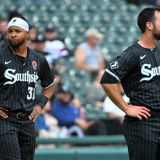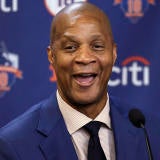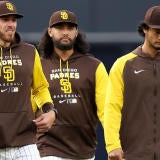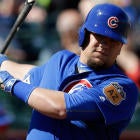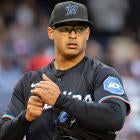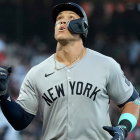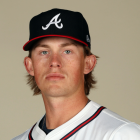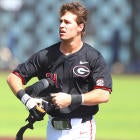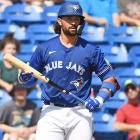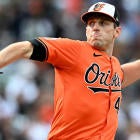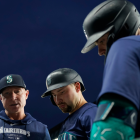Watch the Jonah Keri Show, every Friday from 2:30-3 p.m. ET live on CBSSports.com or watch the most recent episode here.
A new pitch. An improved batting eye. An extra 10 pounds of muscle. Every year, a small group of players will break out, smashing old performance levels and establishing themselves as young stars, thanks to ... something. Figuring out which players might make the leap takes all kinds of number-crunching, and a little bit of dumb luck.
Welcome to the 2017 edition of the MLB Breakout Brigade! Last year, I touted Raisel Iglesias and Addison Russell as breakout candidates (sweet!) ... but also Miguel Sano and Maikel Franco (ugh).
We’ve got a fresh batch of breakout candidates for this season. But first, let’s take a look at our ground rules for picking breakouts:
- A player with remaining rookie eligibility can’t be considered a breakout candidate, even if he has already racked up a few at-bats or innings pitched in the big leagues. That disqualifies talented up-and-comers like Andrew Benintendi, Dansby Swanson and Tyler Glasnow.
- A player who has already made the leap can’t put up a breakout season, unless his projected numbers are so far above his previous career bests that he looks like a double-breakout star (like Mookie Betts last year). That disqualifies many already accomplished young players who could continue to perform at a comparable or slightly higher level, including Kris Bryant and Corey Seager.
- This is about real-life value, not fantasy value. If Shawn Kelley saves 30 games for the Nationals, it won’t really be a breakout season in any realm other than your 12-team roto league, since Kelley has already been an excellent reliever the past two seasons in a setup role. The same goes for a player who moves to the cleanup spot and drives in 120 runs (or to the leadoff spot and scores 100) while putting up other numbers similar to his prior results. A bump in team-dependent counting stats isn’t the same thing as a meaningful jump in real-life value.
With those disclaimers established, let’s break down six players who could be in store for big(ger) things this season:
Separating the effects of defense from pitching results can be a tough task. Kyle Hendricks probably doesn’t lead the universe with a 2.13 ERA on any team other than the Cubs and their historically great defense. Then again, not every pitcher could so thoroughly take advantage of that defense the way Hendricks -- a right-hander with terrific command -- did in 2016.
Paxton’s peripheral stats took flight last season, with significant improvements in his strikeout, walk and home-run rates. His fastball jumped a full 2 mph last season, making him an absolute flamethrower of a left-handed starter at 97 mph. He’s fully healthy after missing time with an elbow injury last season. And he has now made 50 starts in the big leagues, thus offering a tantalizing combination of youth and growing experience.
But the biggest predictor of his likely 2017 success is the huge disconnect between his 3.79 ERA and his fielding-independent metrics, which came in a full run lower; among pitchers with as many innings pitched, only Clayton Kershaw, Noah Syndergaard and Jose Fernandez fared better last season on a fielding-independent basis. Realizing their defense wasn’t up to snuff last season, Mariners general manager Jerry Dipoto moved aggressively to upgrade his glove-carriers for this year, most notably rolling with an outfield that will feature three legitimate center fielders.
Put it all together and Paxton’s upside is so high, it might be worth seeing if you can get Vegas to put your money on an extreme long-shot Cy Young bet.
This one almost feels like a cheat. Schwarber crashed the majors in 2015 by hitting .246/.355/.487, then blasting baseballs over scoreboards in that year’s playoffs. Knocked out in early April last season with a knee injury, Schwarber looked likely to stay in cold storage until 2017. Instead, he stormed back months ahead of schedule and raked again in the World Series, showing a mature approach that included a passel of walks and well-timed singles, belying his early reputation as a bit of an all-or-nothing hitter.
Schwarber is healthy and primed for Opening Day, and should see plenty of action despite his defensive limitations. Look for manager Joe Maddon to DH him in all interleague road games and even give him a bit of time behind the plate to keep his catching skills sharp(ish). Just 24 years old, Schwarber is going to crank 30-plus homers and become an on-base fiend this year. His power, batting eye and ticking clock before he becomes a full-time DH somewhere make him the prototype on the Jim Thome Assembly Line.
Fangraphs writer Jeff Sullivan laid out much of the case for Yelich already: The Marlins outfielder shows similar contact rates, similar ability to lay off pitches out of the zone, similar pull rates and other close parallels to Reds hitting savant Joey Votto. The final step before stardom could be a drop in Yelich’s curiously high groundball rate. He did lower that rate to a career-low level in 2016, but that 56.5 percent mark was still fourth highest in the majors, alongside non-power threats like Howie Kendrick and Yunel Escobar.
Every other marker is headed in the right direction. Even with all those groundballs last year, Yelich still set career highs in homers, doubles, walks, pull percentage and hard-hit percentage. He’s just 25 years old and coming off his healthiest season. The time is now for a monster season.
Whoever described the three types of lies as “lies, damn lies, and statistics” was onto something. As much as we love numerical analysis ‘round these parts, it’s easy to manipulate statistics to make misleading or incomplete statements. The stakes might be lower in baseball than in politics, but the same basic idea holds: We need to consider context whenever citing any kind of numbers. For instance, if you have a .330/40-homer hitter on your team, and he’s 0 for 9 lifetime against a certain pitcher, you can take that 0 for 9 and throw it in the trash. It’s a tiny, meaningless sample that does nothing to negate that hitter’s overall excellence.
Normally, I would also attach some level to caution to a player’s first-half versus second-half splits. String a couple of slow-start seasons together with a couple of strong finishes, and you might conclude that a hitter thrives in warm weather.
The exception comes when it’s a very young player just getting his feet wet in the big leagues. The No. 2 overall pick in the 2012 draft and Baseball America’s former No. 1-ranked prospect, Buxton made his major-league debut in 2015 at 21. In retrospect, that promotion probably came too soon: The not-yet-ready center fielder batted just .209/.250/.326 in 46 games that year, showing brief glimpses of his five-tool potential but not enough to grasp sustainable success. The first half of the 2016 campaign offered more of the same, with Buxton batting a mere .212/.253/.364 and striking out seven-plus times for every one walk.
It’s against that backdrop that a surge to .238/.315/.497 in the second half becomes exciting. Yes, Buxton still struggled at times to make contact, still striking out nearly four times more often than he walked. But he also whacked nine homers in 147 at-bats while showing playing a brand of sometimes-spectacular, occasionally shaky defense that still netted out to a better-than-average performance in center -- at age 22. A five-tool talent with this strong a pedigree doesn’t usually stay down for long. This could be the year we start to see the real Byron Buxton.
Bregman’s entire rookie campaign looked a lot like the second half that got Buxton fans so excited. In 49 games, the Astros rookie hit .264/.313/.478, struggling with strike zone management but making up for it by slashing a ton of doubles and triples -- 40-plus two-baggers and 10 three-baggers prorated over an entire season. Consider that he opened his major-league career with a 1-for-32 start, and those numbers look even more impressive.
Nobody’s doubting that Bregman’s plate discipline will improve soon, his first taste of the majors notwithstanding. After getting drafted second overall in the 2015 draft, Bregman shredded minor-league pitching, hitting .300/.388/.503 with 76 walks and just 68 strikeouts in 679 plate appearances across four levels. And unlike Yelich, Bregman won’t need to make any adjustments in his batted-ball profile to keep pouring on the extra-base hits: Only five other hitters with as many times at bat last year strafed more line drives than Bregman, and only three bounced fewer groundballs.
Here’s another player who might simply need a full season of playing time for his numbers to take off. Given 69 1/3 innings to work with last season, Norris punched out more than a batter an inning and whiffed more than three batters for every one he walked. Like Paxton, his fastball picked up velocity, jumping by 1.5 mph to 94 in 2016.
The path to success from here might simply come down to health. Norris fought through thyroid cancer two years ago, then eased back into the fold in 2016, splitting time between Triple-A and the majors while hitting the DL two more times. Taking the ball 30 times this season could help Norris iron out some inconsistency when it comes to his splits too: Right-handed batters smacked him for a .290/.332/.469 last year, though that came after Norris posted reverse splits in the first 66 2/3 innings of his big league career. A fastball-dominant lefty, Norris’ secret to consistent results could lie with his changeup: Right-handed hitters have feasted on the pitch so far in his young major-league career, but it was an effective weapon against righties in the minors.
Norris turns 24 next month, and looks like a good candidate to put it all together at some point in the future. Doing so this season can’t be ruled out.




















